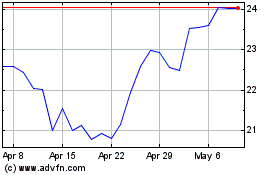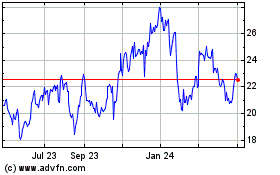By Jay Greene
Microsoft Corp. and its partners unveiled new laptops aimed at
challenging Alphabet Inc.'s Google at the low-end of the education
market and Apple Inc. at higher prices.
The marquee device was Microsoft's new Surface Laptop, a sleek
$999 device that comes in four colors and is meant to compete with
Apple's MacBook Air.
Microsoft's partners, including Acer Inc., Lenovo Group Ltd. and
HP Inc., also rolled out new low-cost laptops for students and
teachers starting at $189. Those devices are aimed helping
Microsoft catch up in the education market, which Google has seized
with its Chrome operating system designed for low-cost laptops.
Devices running Chrome OS accounted for 58% of operating-system
shipments to the U.S. kindergarten-through-12th-grade market in
2016, according to Futuresource Consulting Ltd. Windows registered
a 22% share.
All of the new devices run Windows 10 S, a new variant of
Microsoft's flagship operating system. The new OS only permits
users to run apps obtained through Microsoft's online Windows
Store, which the company says makes the devices more secure and
easier to manage.
While on stage, Terry Myerson, executive vice president of the
Windows and Devices Group, said the S stands for "streamlined,
significant performance, security." He added, "I personally like to
think of it as the soul of today's Windows."
The new devices come after Microsoft revealed its struggles with
Surface computers in the quarter ended March 31. Revenue for the
hardware line plummeted 26% in the quarter as Microsoft wrestled
with older models in the market, as well as increased price
competition.
Chromebooks have been particularly popular with students and
teachers because they are easy to manage. Customers who use the
devices, which can cost as little as $150, spend much of their time
in browser-based apps such as Gmail and Google Docs. The devices
and apps are updated automatically, making them particularly
appealing to schools, which often don't have technical staff to
manage devices.
While the $189 starting price for Windows 10 S devices is higher
than the entry-level prices for Chromebooks, Microsoft said the
laptops will support pen-based computing and apps that make use of
augmented reality.
The company is also introducing updates to the education version
of its Office 365 productivity application that will run in Windows
10 S and will be available free to students, faculty and school
staff. They will also get a free one-year subscription to an
education version of Microsoft's popular Minecraft game that
schools can use to teach coding.
"We think we're entirely competitive in terms of price,"
Microsoft corporate vice president Joe Belfiore said in an
interview.
Other than limiting apps to those from the Windows Store, there
is little difference between Windows 10 S and the widely used
Windows 10 Pro, the version sold to businesses. If customers want
to use apps not available in the Windows Store, such as Apple's
iTunes or Google's Chrome browser, they can pay $49 to upgrade.
Microsoft said its Surface Laptop can be preordered and will be
available June 15. The other devices will be available this summer,
in time for the back-to-school shopping. Schools will be able to
buy them in bulk, and consumers will be able to pick them up at
retail.
The new Surface Laptop weighs 2.76 lbs. and measures 14.47
millimeters at its thickest point. It has a 13.5-inch screen, and a
fabric-covered keyboard. According to Microsoft, the battery will
last for 14.5 hours.
Microsoft also updated the version of Office 365 offered to
students and teachers. The company added Teams, a
workplace-collaboration service introduced in November that
competes with Slack Technologies Inc. The service includes features
to let teachers run quizzes and help students join forces on school
projects.
The new products should "stem the bleeding" for Microsoft in the
education market, Forrester Research Inc. analyst J.P. Gownder
said.
"The cost of Windows was way too high for schools," he said.
Microsoft's focus on reducing device-management costs and
headaches will likely lure some schools to the devices, Mr. Gownder
said. He said he believes schools will be willing to pay a bit more
for the Windows 10 S devices because of the Office 365 and
Minecraft tie-ins.
"You can't do that with Chromebooks," he said.
Still, one challenge Microsoft might face is with consumers
choosing between PCs running different variants of Windows. Five
years ago, the software giant introduced Windows RT, a version of
the operating system focused on the tablet market that only worked
with a specific type of computer chip. Windows RT struggled, in
part, because consumers got frustrated by the limited number of
apps it ran.
Customers who buy Windows 10 S devices could be similarly
frustrated by the inability to sync their iPhones, since iTunes
isn't available in the Windows Store. Microsoft will need to be
clear in its marketing around the operating system, Mr. Gownder
said.
Microsoft's Mr. Belfiore believes customers will understand the
difference, and said those who buy Windows 10 S devices can easily
upgrade.
"If you need to switch out to Pro, that's OK," Mr. Belfiore
said. "That's how we designed the system."
Write to Jay Greene at Jay.Greene@wsj.com
(END) Dow Jones Newswires
May 02, 2017 12:59 ET (16:59 GMT)
Copyright (c) 2017 Dow Jones & Company, Inc.
Lenovo (PK) (USOTC:LNVGY)
Historical Stock Chart
From Dec 2024 to Jan 2025

Lenovo (PK) (USOTC:LNVGY)
Historical Stock Chart
From Jan 2024 to Jan 2025
